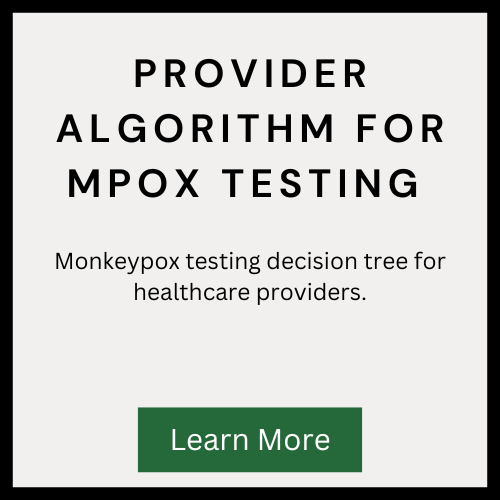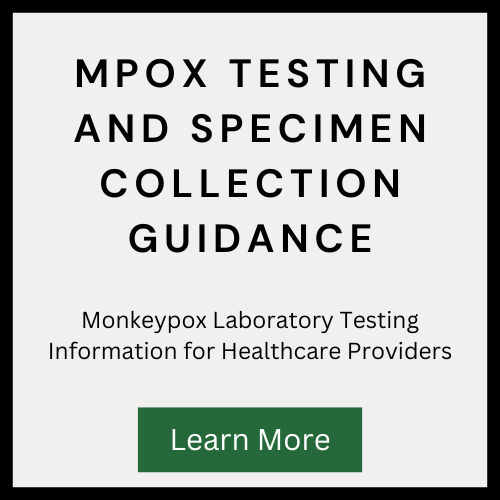Mpox Information for Healthcare Providers
If you are not a healthcare provider, you can refer to mpox (mt.gov) for general information for community members.
|
Are my patients eligible for the JYNNEOS (mpox) vaccine?Mpox vaccination is not recommended for the general public, but it is recommended for those at increased risk for infection or at increased risk for developing severe disease. Transmission of mpox primarily occurs from close, personal skin-to-skin contact with someone who has a mpox rash. Vaccination is available in Montana for people who self-identify as being at increased risk for infection. There is no requirement to specify a reason beyond a self-attestation at the time of vaccination. Below are some examples of individuals that may be at increased risk.
Persons who meet the criteria above and are immunocompromised or those who have underlying medical conditions that confer increased risk for severe disease (e.g., atopic dermatitis, eczema, HIV) should be prioritized for vaccination.Post- Exposure Prophylaxis (PEP):
|
Healthcare providers should report all suspect mpox cases to your local health department. This will allow public health to quickly begin case investigations and to distribute vaccine to close contacts in the event an individual meets the clinical and/or epidemiologic criteria for a high suspect mpox case.
CDC’s website contains additional information about mpox for healthcare providers, include:
Information on mpox infection prevention and control in healthcare settings is provided on the CDC website.
Patient Placement
- Patients with suspected or confirmed mpox infection should be placed in a single-person room. The door should be kept closed (if safe to do so).
- The patient should have dedicated equipment and bathroom.
- If the patient is transported outside of their room, they should use a well-fitted source control mask and have all skin lesions covered.
- Intubation and extubation, and any procedures likely to spread oral secretions, should be performed in an airborne infection isolation room.
Transmission-Based Precautions
- If a patient presents with signs and symptoms for mpox, infection prevention and control personnel should be notified immediately.
- Recommendations for infection prevention and control in healthcare settings are available in Guideline for Isolation Precautions: Preventing Transmission of Infectious Agents in Healthcare Settings
- PPE should include a gown, gloves, eye protection that covers the front and sides of eyes (goggles or face shield), and NIOSH-approved particulate respirator N95.
- Precautions should be maintained until all lesions have crusted, those crusts have separated, and a fresh layer of healthy skin has formed underneath.
Environmental Infection Control
- Standard cleaning and disinfection procedures should be performed using an EPA-registered hospital-grade with an emerging viral pathogen claim, which may be found on EPA's Q List. Follow the manufacturer's direction for concentration, contact time, and care and handling.
Infection prevention and control questions for mpox can be directed to Erika Baldry at erika.baldry@mt.gov.
Correct and consistent use of PPE when caring for a patient with mpox infection is highly protective and prevents transmission to HCP. However, unrecognized errors during the use of PPE (e.g., self-contaminating when removing contaminated PPE) may create opportunities for transmission to HCP. Therefore, in the absence of an exposure described below, HCP who enter a contaminated patient room or care area while wearing recommended PPE, should be aware of the signs and symptoms of mpox; if any signs or symptoms of mpox occur, HCP should notify occupational health services for further evaluation and should not report to work (or should leave work, if signs or symptoms develop while at work).
| Risk level of exposure | Exposure characteristics | Recommendations | |
| Monitoring | PEP¶ | ||
| Higher | Unprotected contact between an exposed individual’s broken skin or mucous membranes and the skin lesions or bodily fluids from a patient with mpox (e.g., inadvertent splashes of patient saliva to the eyes or mouth of a person), or soiled materials (e.g., linens, clothing) -OR- | Yes | Recommended
|
| Being inside the patient’s room or within 6 feet of a patient with mpox during any medical procedures that may create aerosols from oral secretions (e.g., cardiopulmonary resuscitation, intubation), or activities that may resuspend dried exudates (e.g., shaking of soiled linens), without wearing a NIOSH-approved particulate respirator with N95 filters or higher and eye protection | |||
| Intermediate | Being within 6 feet for a total of 3 hours or more (cumulative) of an unmasked patient with mpox without wearing a facemask or respirator -OR- | Yes | Informed clinical decision making recommended on an individual basis to determine whether benefits of PEP outweigh risks of transmission or severe disease ¶¶ |
| Unprotected contact between an exposed individual’s intact skin and the skin lesions or bodily fluids from a patient with mpox, or soiled materials (e.g., linens, clothing) -OR- | |||
| Activities resulting in contact between an exposed individual’s clothing and the patient with mpox’s skin lesions or bodily fluids, or their soiled materials (e.g., during turning, bathing, or assisting with transfer) while not wearing a gown | |||
| Lower | Entry into the contaminated room or patient care area of a patient with mpox without wearing all recommended PPE, and in the absence of any exposures above | Yes | None |
| No Risk | No contact with the patient with mpox, their contaminated materials, nor entry into the contaminated patient room or care area | No | None |
Vaccines are one important strategy to contain mpox. Montana has received and placed vaccine at several strategic locations to ensure those needing a dose for PEP or PEP++ can access the vaccine quickly. DPHHS will follow CDC vaccination recommendations for mpox vaccination, which may be recommended for the following individuals.
- Certain healthcare and public health response team members designated by public health authorities to be vaccinated for preparedness purposes according to ACIP guidance.
At this time, most clinicians in the U.S. and laboratorians not performing the orthopox generic test to diagnose orthopoxviruses, including Monkeypox virus, are not advised to receive mpox vaccine PrEP
Persons who meet the criteria above and are immunocompromised or those who have underlying medical conditions that confer increased risk for severe disease (e.g., atopic dermatitis, eczema) should be prioritized for vaccination.
- Certain healthcare and public health response team members designated by public health authorities to be vaccinated for preparedness purposes according to ACIP guidance.
At this time, most clinicians in the U.S. and laboratorians not performing the orthopox generic test to diagnose orthopoxviruses, including Monkeypox virus, are not advised to receive mpox vaccine PrEP
*For individuals under the age of 18 years, Jynneos may be administered under the current EUA as a 2-dose 0.5 mL subcutaneous injection given 28 days apart.
Jynneos is given as a 2-dose series given 4 weeks apart, however doses may be given up to 4 days before and up to 7 days after the minimum interval of 28 days. Because Jynneos is licensed as a two-dose series, CDC continues to recommend two doses of Jynneos vaccine to confer maximal protection against mpox Initial doses of Jynneos should be administered within 4 days from the date of exposure in order to prevent onset of the disease. If given between 4-14 days after the date of exposure, vaccination may reduce the symptoms of disease, but may not prevent the disease. Healthcare providers must notify their local health department of patients with confirmed or probable mpox. Local health jurisdictions must coordinate with the CD Epi Section and the State Immunization Program at DPHHS to request and distribute vaccine.
At this time (updated 10/14/2025), MTPHL is NOT able to perform orthopoxvirus testing. Please coordinate testing with a reference laboratory.
-
DPHHS urges healthcare providers to be alert for patients who have rash illnesses consistent with mpox, regardless of whether they have travel or specific risk factors for mpox, and regardless of gender or sexual orientation.
Healthcare providers are required to notify their local health department of high-suspect mpox cases and of any positive mpox results from reference laboratories, during daytime hours, including weekends (ARM 37.114.201): /publichealth/FCSS/countytribalhealthdepts. Timely communication with your local health department (LHD) will facilitate a coordinated and prompt public health response in the event of a positive result (i.e., contact tracing, vaccination of high-risk close contacts, therapeutics, etc.). Local public health should immediately contact the DPHHS Communicable Disease Epidemiology Program (CDEpi) at 406-444-0273 to notify the program of a high-suspect mpox case, and share name and date of birth of the suspect case. For high-suspect mpox cases in which vaccination of close contacts or treatment may be needed, LHD and CDEpi are available to discuss suspect mpox cases and treatment requests with providers during daytime hours, including weekends. For public health emergencies, providers may contact the afterhours phone numbers.
At this time (updated 10/14/2025), MTPHL is NOT able to perform orthopoxvirus testing. Please coordinate testing with a reference laboratory.
A positive orthopoxvirus test result is enough for healthcare providers and public health authorities to take necessary actions for the patient and help prevent additional spread, the same actions they would take for a positive mpox test result.
Public health actions can include isolating the patient, initiating treatment if needed, contact tracing, and offering post-exposure vaccination to contacts while confirmatory tests for mpox are under way.
Many mpox infections last 2 to 4 weeks and resolve without treatment. There are no treatments specifically for mpox virus infections. However, the mpox and smallpox viruses are closely related, so treatments developed for smallpox may be used to treat mpox.
The antiviral drug tecovirimat was developed to treat smallpox, and the FDA allows CDC to use it to treat mpox during an outbreak. The need for treatment will depend on how sick someone gets, where lesions are located, and whether they are likely to get severely ill, including individuals with weakened immune systems. The CDC offers Clinical Treatment of Mpox, which includes Interim Clinical Guidance for the Treatment of Mpox, outlining populations in which treatment should be considered.
DPHHS has pre-positioned supplies of tecovirimat in the state for redistribution, when necessary. The state supply of tecovirimat is limited, so DPHHS will review/approve requests before use. The request process is outlined below.
- Provider determines if individual is eligible for treatment with tecovirimat, per CDC.
- Provider contacts DPHHS CDEpi (406-444-0273) to initiate request for an eligible individual.
- DPHHS will work with the provider’s facility to arrange transfer of tecovirimat supply, when indicated.
- DPHHS will share a summary of the CDC reporting requirements for tecovirimat use with the treating provider when treatment is released.
CDC Mpox Treatment Resources
- Tecovirimat (TPOXX) for Treatment of Mpox: Discusses treatment considerations, available formulations, adverse reactions, drug interactions, and special populations. Provides information on the Expanded Access IND protocol for tecovirimat and the online registry; and required and optional forms for tecovirimat use.
- Tecovirimat IND protocol: Contains important medication information, including dosing, administration, patient monitoring, special populations, and safety.
- Clinical Considerations for Mpox in Immunocompromised People: Discusses mpox in people who are immunocompromised and the diagnosis, treatment, and vaccination of people with immunocompromising conditions, including HIV.
- Clinical Considerations for Mpox in Children and Adolescents in the U.S.: Discusses mpox infection in children and adolescent, including signs, testing, management, treatment, and postexposure prophylaxis.
- Clinical Considerations for Pain Management: An aid for healthcare professionals in developing plans for mpox treatment.




